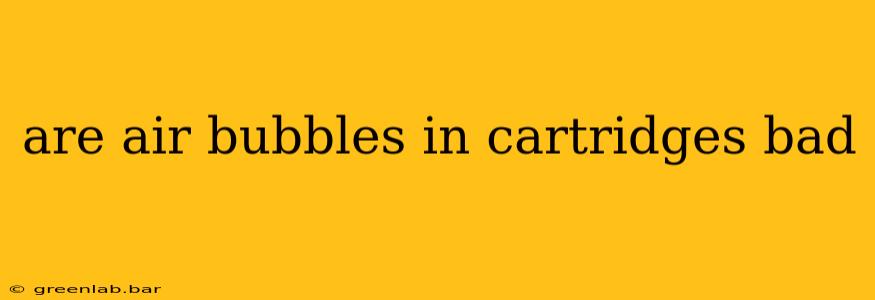Are Air Bubbles in Cartridges Bad? A Comprehensive Guide
Air bubbles in cartridges, whether inkjet or toner, are a common concern for users. While sometimes harmless, they can significantly impact print quality and device performance. This comprehensive guide will delve into the specifics, exploring different cartridge types and offering solutions to this frustrating problem.
Inkjet Cartridges: The Bubble Trouble
In inkjet cartridges, air bubbles can lead to several printing issues:
- Streaking and Banding: Air bubbles disrupt the smooth flow of ink, causing streaks or bands of missing color across your printed pages. This is perhaps the most noticeable and frustrating consequence.
- Clogged Printheads: Air trapped in the printhead can prevent ink from reaching the nozzles, leading to clogged printheads and ultimately, printhead failure. This requires costly cleaning or even replacement.
- Inconsistent Color: Air bubbles can interfere with the precise delivery of ink, resulting in inconsistent color saturation and variations in shade. Your prints might appear faded or blotchy.
- Reduced Ink Levels: While not directly a problem caused by the bubbles, the presence of air can lead to inaccurate ink level readings, giving the false impression that your cartridge is almost empty.
Causes of Air Bubbles in Inkjet Cartridges:
- Cartridge Manufacturing Defects: Some cartridges might contain air bubbles from the manufacturing process.
- Rough Handling: Dropping or shaking the cartridge can introduce air bubbles.
- Improper Installation: Incorrect installation or rapid insertion can trap air inside.
- Temperature Fluctuations: Extreme temperature changes can affect the ink's viscosity, making it more susceptible to trapping air.
Toner Cartridges: A Different Story
While air bubbles can also appear in toner cartridges, their impact is generally less severe than in inkjet cartridges. Toner is a powder, not a liquid, and its flow isn't as easily disrupted by small amounts of air.
However, significant air pockets in a toner cartridge can cause:
- Faint Prints: If a substantial air pocket is present, it might impede the even distribution of toner, leading to lighter or fainter prints.
- Toner Spillage: In rare cases, excessive air pressure within the cartridge could cause toner to spill, leading to messy prints and potential damage to your printer.
Addressing Air Bubbles: Solutions and Prevention
For Inkjet Cartridges:
- Gentle Handling: Always handle cartridges carefully, avoiding drops or excessive shaking.
- Proper Installation: Ensure you correctly install the cartridge according to the printer's instructions.
- Printer Cleaning Cycles: Run the printer's built-in cleaning cycles. This can often dislodge minor air bubbles.
- Priming the Cartridges (if applicable): Some printers and cartridges require manual priming to remove air bubbles before use. Check your printer's manual.
- Storage: Store cartridges upright in a cool, dry place.
For Toner Cartridges:
- Gentle Handling: Similar to inkjet cartridges, avoid rough handling.
- Proper Installation: Correct installation is crucial for preventing issues.
When to Replace a Cartridge:
If air bubbles persist despite trying these solutions, or if the print quality remains significantly impaired, it’s likely time to replace the cartridge. Persistent air bubbles often indicate a more serious underlying issue, potentially involving the cartridge's internal mechanisms.
Conclusion: Don't Panic, But Do Act
Air bubbles in cartridges are a common, albeit sometimes annoying, problem. Understanding their potential impact and taking preventative measures can greatly reduce the frequency of this issue and maintain high-quality printing. If the problem persists after attempting the solutions above, contacting the printer manufacturer's support is recommended.

